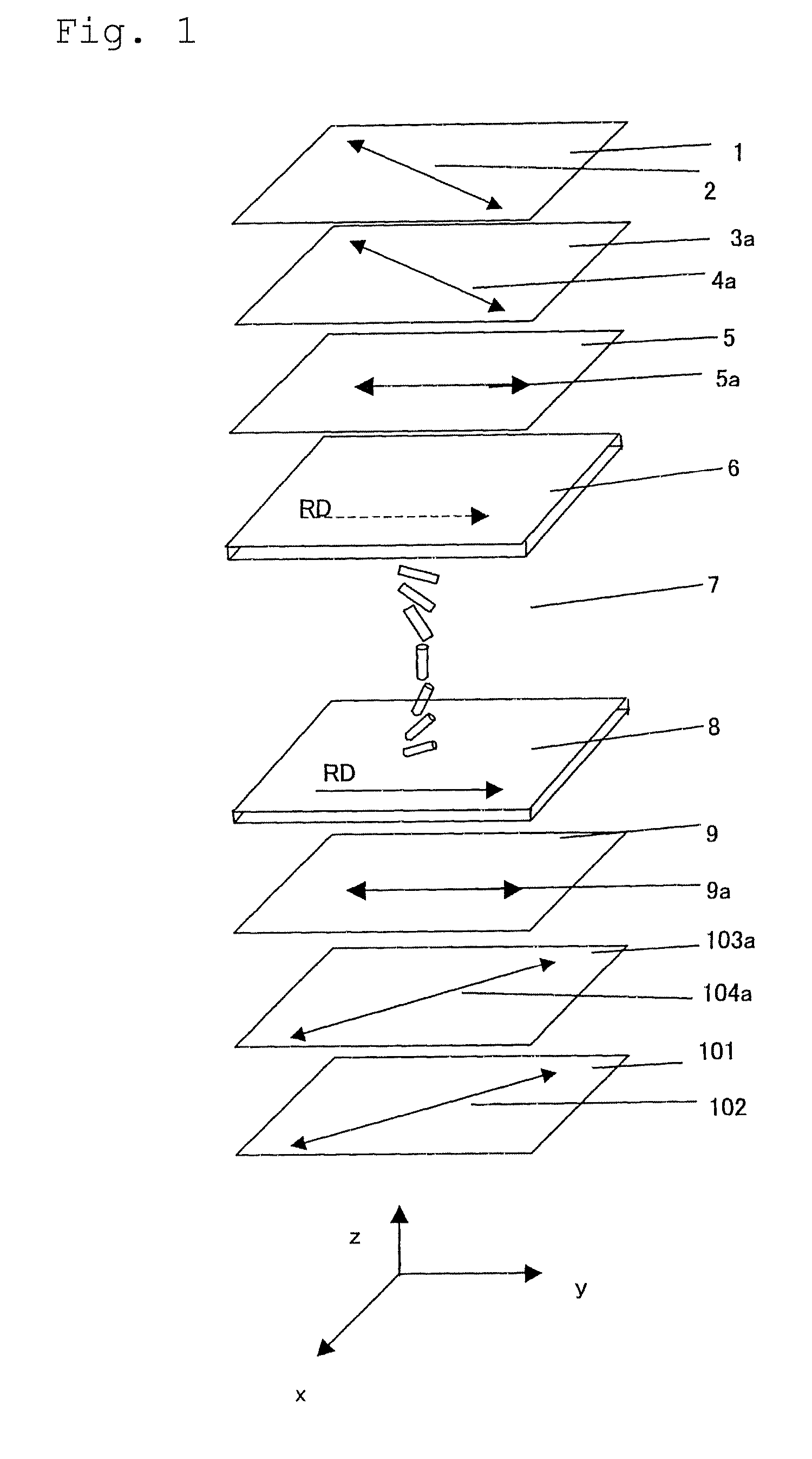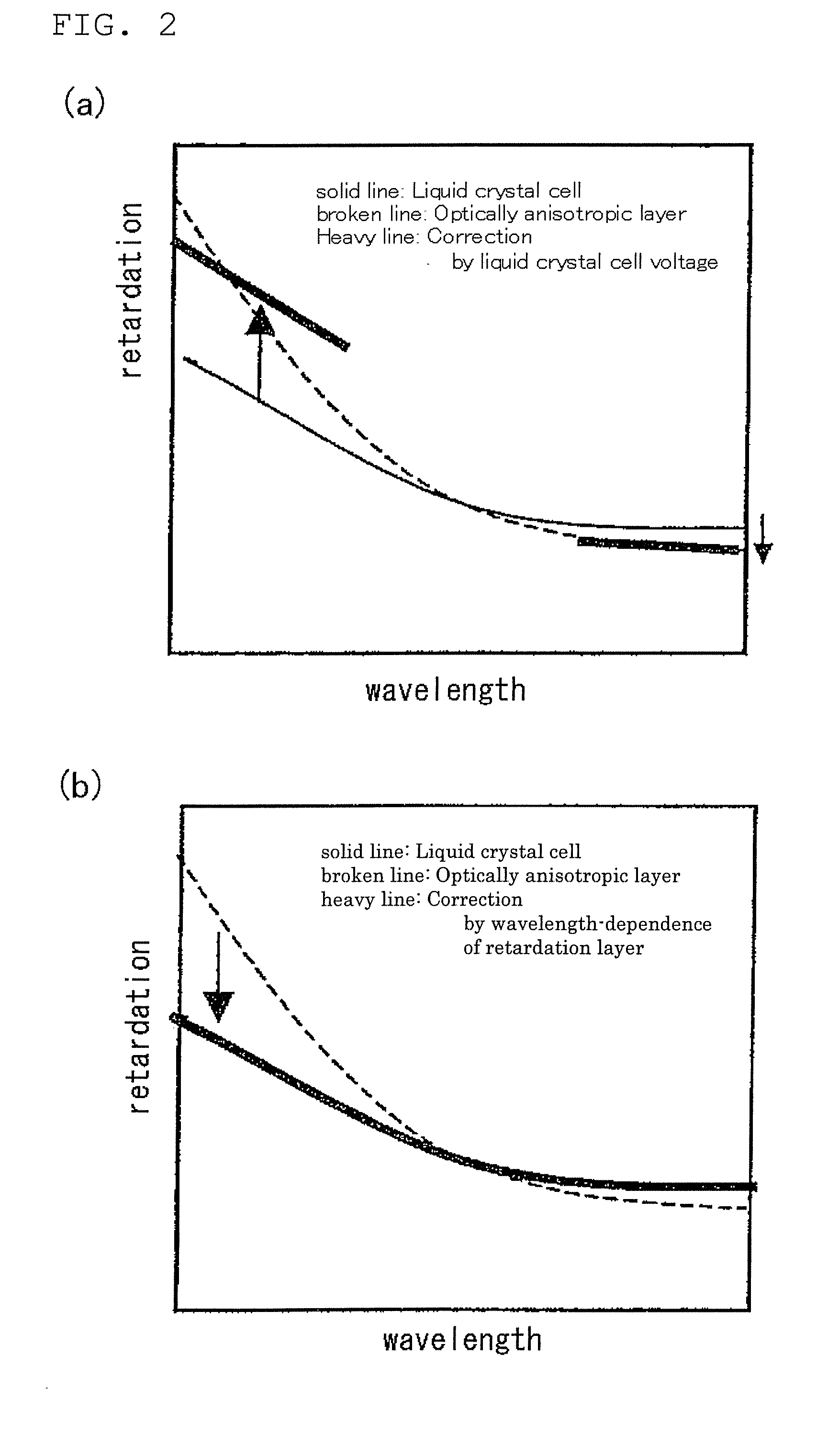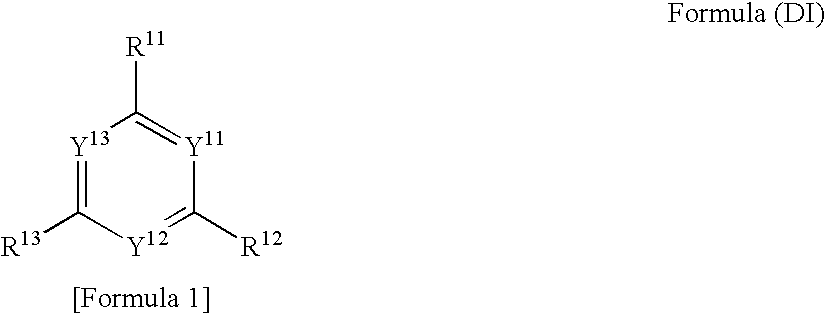Optical Compensation Film, Method of Producing the Same, and Polarizing Plate and Liquid Crystal Display Device Using the Same
a technology of optical compensation film and polarizing plate, which is applied in the direction of polarising elements, thin material processing, instruments, etc., can solve the problem that it is difficult to obtain desirable viewing angle characteristics
- Summary
- Abstract
- Description
- Claims
- Application Information
AI Technical Summary
Benefits of technology
Problems solved by technology
Method used
Image
Examples
example 1
Preparation of Optical Compensation Film (Samples 001 to 010)
[0219]Individual ingredients of a cellulose acetate solution composition, shown below, were placed into a mixing tank, stirred under heating so as to dissolve them, to thereby prepare a cellulose acetate solution.
(Composition of Cellulose Acetate Solution)Cellulose acetate, degree of acetylation 60.9%83 parts by massCellulose acetate, degree of acetylation 55.0%17 parts by massTriphenyl phosphate (plasticizer)7.8 parts by mass Biphenyl diphenyl phosphate (plasticizer)3.9 parts by mass Methylene chloride (first solvent)318 parts by mass Methanol (second solvent)47 parts by mass
[0220]In a separate mixing tank, 16 parts by mass of retardation enhancer shown below, 0.1 to 32 parts by mass of dispersion adjusting agent UV-102 shown below, 87 parts by mass of methylene chloride and 13 parts by mass of methanol were placed, stirred under heating, to thereby prepare a retardation controlling agent solution.
[0221]Thirty-six parts b...
example 2
Preparation of Polarizing Plate
[0235]A stretched polyvinyl alcohol film was allowed for absorption of iodine to thereby manufacture the polarizing film, and the optical compensation film (Sample 001) produced in Example 1 was bonded to one surface of the polarizing film, using a polyvinyl alcohol-base adhesive. The transmission axis of the polarizing film and the slow axis of the retardation plate were aligned in parallel with each other.
[0236]A commercially-available cellulose triacetate film (Fujitac TD80UF, from FUJIFILM Corporation) was saponified, and bonded on the opposite side of the polarizing film, using a polyvinyl alcohol-base adhesive. The polarizing plate was thus produced.
[0237]Polarizing plates were similarly produced except that Sample 001 was replaced respectively with sample 002 to sample 011.
example 3
On-Device Evaluation in Liquid Crystal Display Device
(Production of Bend-Aligned Liquid Crystal Cell)
[0238]A polyimide film was provided as an alignment layer to a glass substrate having ITO electrodes formed thereon, and the alignment layer was rubbed. Two thus-obtained glass substrates were opposed so as to align the direction of rubbing in parallel with each other, and the cell gap was adjusted to 4.0 μm. A liquid crystalline compound (ZLI1132, from MERCK) having Δn of 0.1396 was injected into the gap, to thereby produce a bend-aligned liquid crystal cell.
[0239]Two produced polarizing plates were bonded to the bend-aligned cell so as to hold it in between, while making the optically anisotropic layers of the polarizing plates contacted with the cell substrates, and making the direction of rubbing of the liquid crystal cell aligned anti-parallel to the direction of rubbing of the optically anisotropic layer contacted therewith.
[0240]A rectangular wave voltage of 55 Hz was applied ...
PUM
| Property | Measurement | Unit |
|---|---|---|
| viscosity | aaaaa | aaaaa |
| optically anisotropic | aaaaa | aaaaa |
| wavelength-dependence α2 | aaaaa | aaaaa |
Abstract
Description
Claims
Application Information
 Login to View More
Login to View More - R&D
- Intellectual Property
- Life Sciences
- Materials
- Tech Scout
- Unparalleled Data Quality
- Higher Quality Content
- 60% Fewer Hallucinations
Browse by: Latest US Patents, China's latest patents, Technical Efficacy Thesaurus, Application Domain, Technology Topic, Popular Technical Reports.
© 2025 PatSnap. All rights reserved.Legal|Privacy policy|Modern Slavery Act Transparency Statement|Sitemap|About US| Contact US: help@patsnap.com



